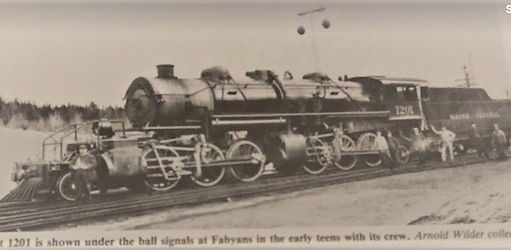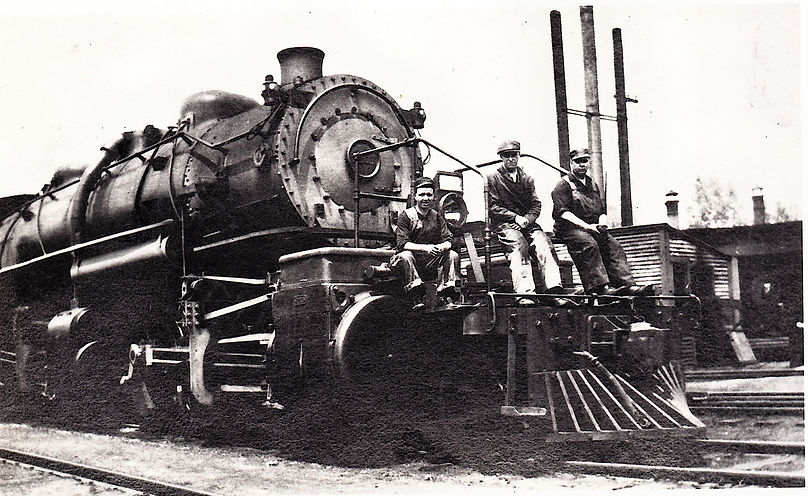BARTLETT HISTORIC SOCIETY PO Box 514 - 13 School St.
Bartlett, NH 03812

More Railroad Pages - Menu Top Right...
Scotty Calls Them "Big Pigs"
Actually, "Pigs" is not unique Scotty language. They were nicknamed " pigs" because the locomotives had to have 2 firemen shoveling coal from when they departed Bartlett until they arrived at Crawford Depot.
These locomotives 1201-1204 were class x. Locomotives 1202 and 1203 were assigned as helpers out of Bartlett and the reason the turntable was removed...(they were too big to use it) and the Bartlett Wye was constructed.

The Mallet locomotive is a type of articulated steam railway locomotive, invented by the Swiss engineer Anatole Mallet (1837–1919).
The articulation was achieved by supporting the front of the locomotive on an extended Bissel truck. The compound steam system fed steam at boiler pressure to high-pressure cylinders driving the main set of wheels. The exhaust steam from these cylinders was fed into a low-pressure receiver and was then sent to low-pressure cylinders that powered the driving wheels on the swiveling bogie.

Class X 2-6-6-2 Mallet Articulated locomotives
“The Pigs”
Written and researched by Scotty Mallett - Special thanks to Jerry Kelley
In 1910 and 1911 the Maine Central Railroad purchased 4 large locomotives from the Boston and Maine Railroad. These locomotives were built in 1910 for use in the Hoosac Tunnel but became surplus when the tunnel became electrified in 1911. Numbered 1201-1204, The locomotives were “articulated” allowing to take the sharp turns of the “Mountain Division”.
The 1202 was assigned to helper service out of Bartlett. The east end of the Wye in Bartlett was constructed, and the turntable removed and Stall 1 (Route 302 side) was lengthened to 105’ Upon arrival on the B&M 1201-1204 were fueled by coal and then converted to Bunker C oil which left a greasy film on fresh laundry and on houses. It also caused oil related fires which could only be extinguished by steam from another locomotive, so in 1912 all 4 Mallets (pronounced Mal lay) were converted by the Maine Central shops back to coal. From then on it took 2 firemen shoveling coal into the firebox constantly to create enough steam to power these giants. The crews of the Maine Central Railroad called them “pigs” as they ate so much coal.
These locomotives were so large that 2 of them could not be run together as their combined weight was too much for some off the Trestles and Bridges and they also had a 20-mile an hour speed restriction on the entire Maine Central Railroad system.
In 1917 at South Windham, Maine mallet # 1203 was involved in a head on collision with another train due to misunderstood train orders. 1203 was rebuilt and lasted in service longer than all the mallets. The 1201, 1202 and 1204 were scrapped in 1929 and the 1203 was scrapped January 15,1931.
Here are some statistics:
Length: 86 feet
Height: (to top of stack) 14 feet 86 inches
Weight: more than 200 tons - still under research
Oil use: 10 gallons a mile
Class details:
The Mallett 1201. This engine was used to deliver groceries to the Mt Willard Section House, among other things.
Photo courtesy Robert Giroud's Ray Evans collection
